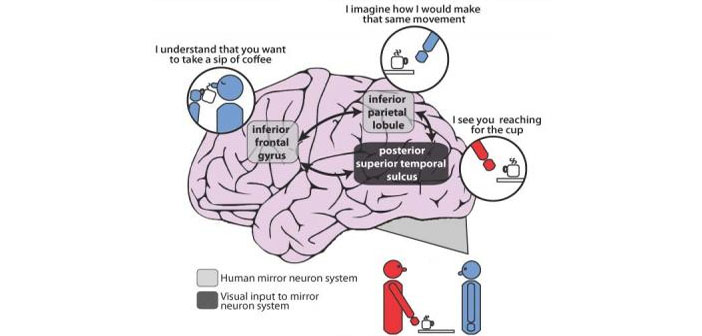Action Observation Therapy
Original Editor - Redisha Jakibanjar
Top Contributors - Redisha Jakibanjar, Kim Jackson, Candace Goh, Admin, Aminat Abolade and Uchechukwu Chukwuemeka
Introduction[edit | edit source]
Action Observation (AO) is a dynamic state during which the observer can understand what the other is doing by simulating the actions and outcomes that are likely to follow from the observed motor act.[1]
Action Observation Therapy (AOT) is a top down approch and is grounded in basic neuroscience and the recent discovery of the mirror neuron system (MNS)[2][3]. AOT commonly includes action observation and action execution and allows patients to safely practice movements and motor tasks.[3]
Purpose[edit | edit source]
- To recover damaged cerebral networks and take advantage to rebuild motor function despite impairments, as an alternative or complement to physiotherapy.[4]
- Promote functional reorganization within the brain via activation of mirror neurons in order to promote motor function recovery.[5]
Technique[edit | edit source]
There are not such specific rule for performing the therapy but still the general process is:
During each rehabilitation session, patients are required to observe a specific object-directed daily action presented through a video clip on a computer screen, and afterwards to execute what they have observed. Only one action is practiced during each rehabilitation session. The presented action can be divided into three to four motor tasks. The presented task can be shown from different perspective for the better outcome[6]
Phases:[edit | edit source]
- Observation phase : during this phase, patient is asked to carefully observe the given video.
- Execution phase: during this phase, patient is asked to perform the observed motor task at the best of his/her ability.[6]
Time duration:[edit | edit source]
There is not such a rule for performing the task but typical AOT rehabilitation session takes half an hour. A few minutes are needed by the physiotherapist to explain the task to the patient (carefully looking at the movie, paying attention also to the details of presented actions) and to motivate him to the task, then 12 min of observation (3 min for each of the motor acts into which the action is divided) and finally 8 min of execution (2 min for each motor act). There is not any evidence available regarding whether a more intensive practice, for example 1 h per session, is better than half an hour.[6]
Resources[edit | edit source]
- bulleted list
- x
or
- numbered list
- x
References[edit | edit source]
- ↑ CERAVOLO MG. Action Observation as a Tool for Upper Limb Recovery. Fizikalna i rehabilitacijska medicina. 2016 Apr 3;28(1-2):144-50.
- ↑ Shih TY, Wu CY, Lin KC, Cheng CH, Hsieh YW, Chen CL, Lai CJ, Chen CC. Effects of action observation therapy and mirror therapy after stroke on rehabilitation outcomes and neural mechanisms by MEG: study protocol for a randomized controlled trial. Trials. 2017 Dec;18(1):459.
- ↑ 3.0 3.1 Ertelt D, Binkofski F. Action observation as a tool for neurorehabilitation to moderate motor deficits and aphasia following stroke. Neural regeneration research. 2012 Sep 15;7(26):2063.
- ↑ Sarasso E, Gemma M, Agosta F, Filippi M, Gatti R. Action observation training to improve motor function recovery: a systematic review. Archives of physiotherapy. 2015 Dec;5(1):14.
- ↑ Zhu MH, Wang J, Gu XD, Shi MF, Zeng M, Wang CY, Chen QY, Fu JM. Effect of action observation therapy on daily activities and motor recovery in stroke patients. International Journal of Nursing Sciences. 2015 Sep 1;2(3):279-82.
- ↑ 6.0 6.1 6.2 Buccino G. Action observation treatment: a novel tool in neurorehabilitation. Phil. Trans. R. Soc. B. 2014 Jun 5;369(1644):20130185.







